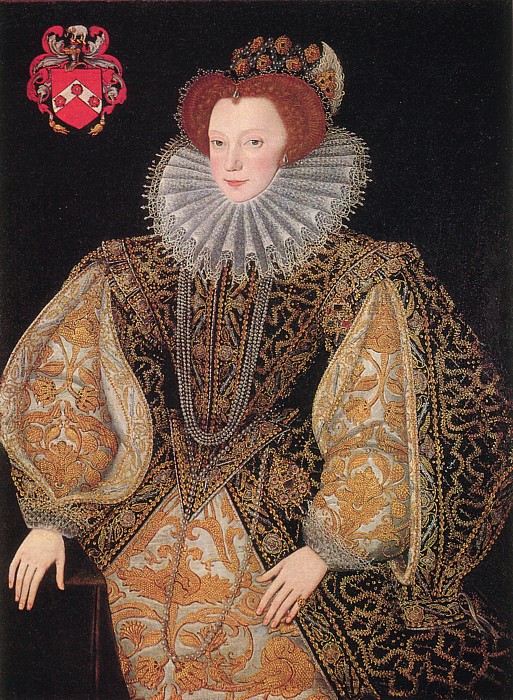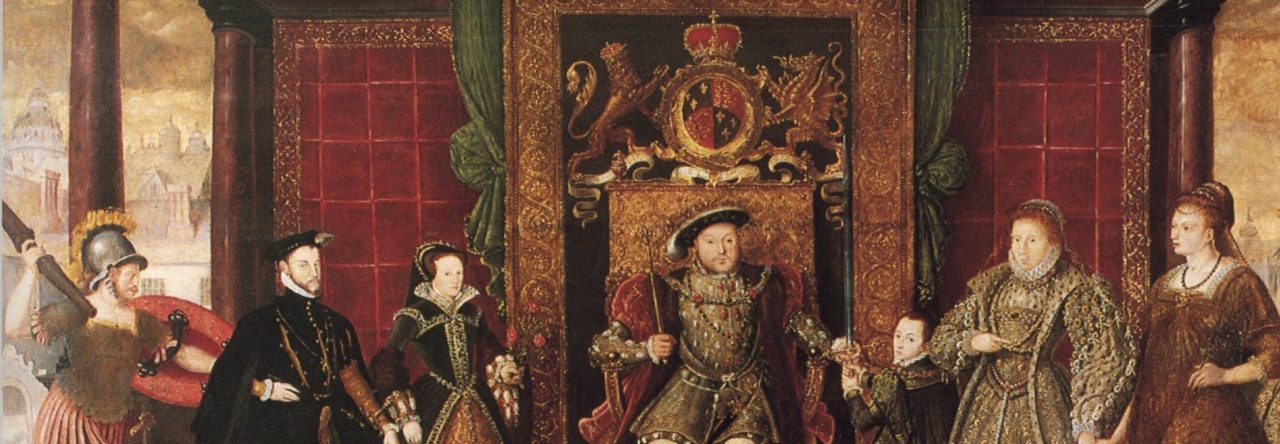 (Born November 8, 1543- Died December 25, 1634)
(Born November 8, 1543- Died December 25, 1634)
Daughter of Sir Francis Knollys and Catherine Carey.
Married to Walter Devereux, 1st Earl of Essex, Robert Dudley, 1st Earl of Leicester, and Christopher Blount.
Mother of Penelope Rich, Dorothy Percy, Countess of Northumberland, Robert Devereux, 2nd Earl of Essex, Walter Devereux, Francis Devereux, and Robert Dudley, Lord Denbigh.
Lettice Knollys was one of Elizabeth I’s favorites at court, but when she married Elizabeth’s favorite Robert Dudley, she was banished from court.
Lettice Knollys was born on November 8, 1543 at Rotherfield Greys, Oxfordshire to Sir Francis Knollys and Catherine Carey. Sir Francis Knollys was a member of Parliament and Master of the Horse under King Edward VI. Her mother, Catherine Carey, was the daughter of Mary Boleyn, which made Lettice Knollys and Elizabeth I first cousins once removed. The Knollys were Protestants and in 1556, during the reign of Mary I, they fled with five of their children to Frankfurt, Germany. We do not know if Lettice was in Germany with her family or if she spent the years her family was in exile with her cousin Elizabeth. Lettice’s family returned to England in January 1559, after the death of Mary I and the accession of Elizabeth I. Sir Francis Knollys was appointed Vice-Chamberlain of the Royal Household, Catherine was made a senior Lady of the Bedchamber, and Lettice was made a Maid of the Privy Chamber.
In the early 1560’s Lettice married her first husband Walter Devereux, Viscount Hereford. They lived at Chartley in Staffordshire, where the two eldest of their five children, Penelope and Dorothy, were born in 1563 and 1564. It is said that when Lettice was pregnant with her first son that she flirted with Robert Dudley at court, but there is no proof to support this rumor. In November 1565, Lettice gave birth to her first son Robert Devereux. In 1569, she gave birth to her son Walter Devereux and her son Francis shortly after, but Francis would die shortly after his birth.
Walter held no position at court, but following the outbreak of the Northern Rebellion in 1569, he became known for his loyal military service to Elizabeth I. Elizabeth rewarded this loyalty by making Walter Devereux the Earl of Essex in 1572. In 1573, Walter Devereux successfully convinced Elizabeth to send him to Ulster so that he could colonize it for England. He was gone for two years, leaving Lettice alone to take care of her five children. Lettice during this time visited friends at court and at Kenilworth Castle, where Robert Dudley lived. Rumors began to spread that Robert Dudley and Lettice were having an affair while her husband was away. In December 1575, Walter Devereux returned to England, but he would leave again for Ireland in July 1576. Walter died of dysentery on September 22, 1576 in Dublin, but rumors began to swirl that Robert Dudley had him poisoned so that he could marry Lettice. Walter’s death left Lettice deep in debt and she had to move in with her friends and into her family home. She tried to convince the crown to lower the debt for her son, the new earl of Essex, but Elizabeth did not agree to this agreement.
Lettice did marry again in secret, to Robert Dudley Earl of Leicester, on September 21, 1578. There were only a few witnesses to this ceremony. When Elizabeth found out about the marriage the following year, in July 1579, she was absolutely furious. Elizabeth focused all her anger on Lettice and banished her forever from court and Robert fled from court in disgrace. Lettice continued to style herself Countess of Essex for several years into her new marriage. She lived very discreetly, often with her relatives at the Knollys family home in Oxfordshire. Lettice’s son with Leicester, Robert, Lord Denbigh, was born in June 6, 1581, at Leicester House. Three years later, on July 18, 1584, Lord Denbigh tragically died. Lettice and Robert would not have any more children.
In 1585 Leicester led an English expedition to assist the rebellious Netherlands against Spain. He incurred Elizabeth’s wrath when he accepted the title of Governor-General in January 1586. At this same time the Earl was giving his wife authority to handle certain land issues during his absence, implying they had no plans to meet in Holland.
The Earl returned to England in December 1586, but was sent again to the Netherlands in the following June. Leicester eventually resigned his post in December 1587. Lettice was with him when he died unexpectedly, possibly of malaria, on 4 September 1588 at Cornbury Park, Oxfordshire. Leicester’s death left Lettice deeper in debt and she had to marry again in order to repay her two deceased husbands’ debts.
In March or April of 1589, Lettice married her third husband Sir Christopher Blount. Blount was a man who came from a lowly gentry family and he served in the Leicester household. Lettice’s son the Earl of Essex was not thrilled about her choice of husband, however Blount would prove extremely loyal to Essex. Blount was so loyal to his stepson, that he became one of the key conspirators in Essex’s rebellion in February 1601. The rebellion, which aimed to depose the Queen’s government, was a disaster ,and both Essex and Blount were imprisoned. Though Blount begged for mercy he was condemned for treason. Essex was executed in February 1601 and Blount was executed on March 18, 1601.
When Elizabeth I died in 1603, King James I decided to cancel all of the debts that Lettice owned through her husbands and restore her grandson, the third Earl of Essex, to his father’s title and estate. Also in 1603, Ambrose Dudley, the son of Robert Dudley and Douglas Sheffield, claimed that he was the legitimate son of his parents and thus the heir to the earldoms of Warwick and Leicester. If successful, this claim would not only have implied that Lettice Knollys’ union with Leicester had been bigamous, but would also have nullified her jointure rights. In February 1604, Lettice filed a complaint against Dudley in the Star Chamber, accusing him of defamation. The other side was unable to cite clear evidence and the King’s chief minister, Robert Cecil, thought it unwise to rake up the existing property settlement, so the outcome was in favour of Lettice. Lettice would die at the age of 91 on December 25, 1634. She was buried next to Robert Dudley at St Mary’s Church, Warwick.
Sources:
https://en.wikipedia.org/wiki/Lettice_Knollys
http://tudortimes.co.uk/guest-articles/lettices-men
http://www.berkshirehistory.com/bios/lknollys.html
 Illegitimate royal children have been known to make an impact on history. Take Henry Fitzroy, the illegitimate son of Henry VIII, and Bessie Blount, whom Henry VIII acknowledged as his son. There were discussions about Henry Fitzroy becoming the heir apparent if Henry VIII did not have a legitimate son. But what about the illegitimate children that a king did not acknowledge? What might their lives have been like? The story of Mary Boleyn and her affair with King Henry VIII has been told many times, but the story of her daughter born during that time is lesser known. In her first full-length nonfiction book, “Henry VIII’s True Daughter: Catherine Carey, A Tudor Life,” Wendy J Dunn has taken on the task of discovering the truth of Catherine Carey’s parentage and how it impacted her life.
Illegitimate royal children have been known to make an impact on history. Take Henry Fitzroy, the illegitimate son of Henry VIII, and Bessie Blount, whom Henry VIII acknowledged as his son. There were discussions about Henry Fitzroy becoming the heir apparent if Henry VIII did not have a legitimate son. But what about the illegitimate children that a king did not acknowledge? What might their lives have been like? The story of Mary Boleyn and her affair with King Henry VIII has been told many times, but the story of her daughter born during that time is lesser known. In her first full-length nonfiction book, “Henry VIII’s True Daughter: Catherine Carey, A Tudor Life,” Wendy J Dunn has taken on the task of discovering the truth of Catherine Carey’s parentage and how it impacted her life.
 In a time when marrying for love was taboo, one woman took a stand to follow her heart no matter the consequences. Lady Penelope Devereux, the daughter of Lady Lettice Knollys and the step-daughter of Sir Robert Dudley understands how dangerous it is to defy the wishes of Queen Elizabeth I. Her mother and stepfather were banished from court for choosing to marry secretly, but this did not deter Penelope from pursuing love. A story spanning decades, full of love, intrigue, and plots galore, “Penelope- Tudor Baroness” by Tony Riches tells the tale of this remarkable woman and her family.
In a time when marrying for love was taboo, one woman took a stand to follow her heart no matter the consequences. Lady Penelope Devereux, the daughter of Lady Lettice Knollys and the step-daughter of Sir Robert Dudley understands how dangerous it is to defy the wishes of Queen Elizabeth I. Her mother and stepfather were banished from court for choosing to marry secretly, but this did not deter Penelope from pursuing love. A story spanning decades, full of love, intrigue, and plots galore, “Penelope- Tudor Baroness” by Tony Riches tells the tale of this remarkable woman and her family. When we study the life of Queen Elizabeth I, the image of a virgin queen who never married tends to come to mind. Of course, she had a man who she favored above all others, Robert Dudley, but he married several times to Amy Robsart and Lettice Knollys. It was with Lettice Knollys that Robert Dudley was able to produce his heir, aptly named Robert Dudley Lord Denbigh, who unfortunately died at a young age. Robert Dudley was left without a legitimate heir, but he did have another son, albeit an illegitimate son, also named Robert Dudley. Julia A Hickey has decided to examine the life of the illegitimate Robert Dudley in her book, “The Son that Elizabeth I Never Had: The Adventurous Life of Robert Dudley’s Illegitimate Son.”
When we study the life of Queen Elizabeth I, the image of a virgin queen who never married tends to come to mind. Of course, she had a man who she favored above all others, Robert Dudley, but he married several times to Amy Robsart and Lettice Knollys. It was with Lettice Knollys that Robert Dudley was able to produce his heir, aptly named Robert Dudley Lord Denbigh, who unfortunately died at a young age. Robert Dudley was left without a legitimate heir, but he did have another son, albeit an illegitimate son, also named Robert Dudley. Julia A Hickey has decided to examine the life of the illegitimate Robert Dudley in her book, “The Son that Elizabeth I Never Had: The Adventurous Life of Robert Dudley’s Illegitimate Son.” A man who was young and had charisma would attract the attention of the Virgin Queen herself, yet that attention came with a price. The young man could not do what he desired and was buried in debt. His anger could not be quenched and he would end up rebelling against the very queen who brought him so much glory and honor. This rebellion would lead to his execution. The man’s name was Robert Devereux, 2nd Earl of Essex, and his story is told in Sarah-Beth Watkins’ latest bite-size biography, “Elizabeth I’s Last Favourite: Robert Devereux, 2nd Earl of Essex”.
A man who was young and had charisma would attract the attention of the Virgin Queen herself, yet that attention came with a price. The young man could not do what he desired and was buried in debt. His anger could not be quenched and he would end up rebelling against the very queen who brought him so much glory and honor. This rebellion would lead to his execution. The man’s name was Robert Devereux, 2nd Earl of Essex, and his story is told in Sarah-Beth Watkins’ latest bite-size biography, “Elizabeth I’s Last Favourite: Robert Devereux, 2nd Earl of Essex”. Today, I am pleased to share my book review of the latest Elizabethan novel by Tony Riches as my contribution to his “Essex: Tudor Rebel” blog tour. Thank you to Tony Riches for sending me a copy of his latest novel, and to The Coffee Pot Book Club for allowing me to take part in this tour.
Today, I am pleased to share my book review of the latest Elizabethan novel by Tony Riches as my contribution to his “Essex: Tudor Rebel” blog tour. Thank you to Tony Riches for sending me a copy of his latest novel, and to The Coffee Pot Book Club for allowing me to take part in this tour.  (Blurb)
(Blurb) Author Bio
Author Bio The last Tudor monarch, Queen Elizabeth I, was known for many things, but her main legacy is that she never chose to marry anyone. She was the infamous “Virgin Queen”. However, there were those around her who manage to capture her attention and her admiration for a time. The most famous of these men was Robert Dudley, Earl of Leicester. He was a massive supporter of the arts and the Protestant faith, gaining prestige and praise from his highly exalted monarch. Yet, his life and his relationship with his wives, his enemies, and Elizabeth I was full of dangers and numerous scandals. Who was this man who wooed the heart of the most eligible woman in all of 16th century Europe? Robert Stedall investigates the relationship between these two lovers destined to never marry each other in, “Elizabeth I’s Secret Lover: Robert Dudley, Earl of Leicester”.
The last Tudor monarch, Queen Elizabeth I, was known for many things, but her main legacy is that she never chose to marry anyone. She was the infamous “Virgin Queen”. However, there were those around her who manage to capture her attention and her admiration for a time. The most famous of these men was Robert Dudley, Earl of Leicester. He was a massive supporter of the arts and the Protestant faith, gaining prestige and praise from his highly exalted monarch. Yet, his life and his relationship with his wives, his enemies, and Elizabeth I was full of dangers and numerous scandals. Who was this man who wooed the heart of the most eligible woman in all of 16th century Europe? Robert Stedall investigates the relationship between these two lovers destined to never marry each other in, “Elizabeth I’s Secret Lover: Robert Dudley, Earl of Leicester”. The children of Henry VIII have been the center of historical studies for centuries. Edward VI, Mary I, and Elizabeth I were all considered Henry’s “legitimate” children and were able to obtain the crown of England. Henry Fitzroy was the illegitimate son of the king, but he was still able to gain titles and a good marriage before he died. They all had something in common; they were all recognized by their father, Henry VIII. However, there was another child who many believed to have been the daughter of the king. The name of this intriguing lady was Lady Katherine Knollys and her story comes to life in Sarah-Beth Watkins’ book, “Lady Katherine Knollys- The Unacknowledged Daughter of King Henry VIII”.
The children of Henry VIII have been the center of historical studies for centuries. Edward VI, Mary I, and Elizabeth I were all considered Henry’s “legitimate” children and were able to obtain the crown of England. Henry Fitzroy was the illegitimate son of the king, but he was still able to gain titles and a good marriage before he died. They all had something in common; they were all recognized by their father, Henry VIII. However, there was another child who many believed to have been the daughter of the king. The name of this intriguing lady was Lady Katherine Knollys and her story comes to life in Sarah-Beth Watkins’ book, “Lady Katherine Knollys- The Unacknowledged Daughter of King Henry VIII”. The Boleyn family is one of the most notable families during the reign of the Tudors. When one thinks about this family, people like Anne Boleyn, Thomas Boleyn, and George Boleyn come to mind. However, another Boleyn and her family story have been emerging from the shadows of history in recent years. That is the story of Mary Boleyn, a mistress of King Henry VIII. Mary Boleyn had a daughter named Catherine Carey, who married Sir Francis Knollys and was the mother of 14 children, including Lettice Knollys. Since Catherine Carey was a direct relation to the Tudors, what might have her life have been like? Adrienne Dillard wanted to give readers a possible view of Catherine Carey’s life in her book, “Cor Rotto: A Novel of Catherine Carey”.
The Boleyn family is one of the most notable families during the reign of the Tudors. When one thinks about this family, people like Anne Boleyn, Thomas Boleyn, and George Boleyn come to mind. However, another Boleyn and her family story have been emerging from the shadows of history in recent years. That is the story of Mary Boleyn, a mistress of King Henry VIII. Mary Boleyn had a daughter named Catherine Carey, who married Sir Francis Knollys and was the mother of 14 children, including Lettice Knollys. Since Catherine Carey was a direct relation to the Tudors, what might have her life have been like? Adrienne Dillard wanted to give readers a possible view of Catherine Carey’s life in her book, “Cor Rotto: A Novel of Catherine Carey”. 
 (Born November 8, 1543- Died December 25, 1634)
(Born November 8, 1543- Died December 25, 1634)